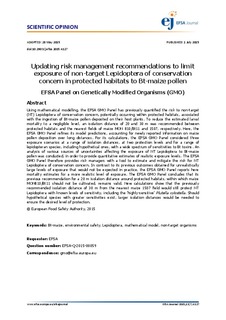| dc.description.abstract | Using mathematical modelling, the EFSA GMO Panel has previously quantified the risk to non-target (NT) Lepidoptera of conservation concern, potentially occurring within protected habitats, associated with the ingestion of Bt-maize pollen deposited on their host plants. To reduce the estimated larval mortality to a negligible level, an isolation distance of 20 and 30 m was recommended between protected habitats and the nearest fields of maize MON 810/Bt11 and 1507, respectively. Here, the EFSA GMO Panel refines its model predictions, accounting for newly reported information on maize pollen deposition over long distances. For its calculations, the EFSA GMO Panel considered three exposure scenarios at a range of isolation distances, at two protection levels and for a range of lepidopteran species, including hypothetical ones, with a wide spectrum of sensitivities to Bt toxins. An analysis of various sources of uncertainties affecting the exposure of NT Lepidoptera to Bt-maize pollen was conducted, in order to provide quantitative estimates of realistic exposure levels. The EFSA GMO Panel therefore provides risk managers with a tool to estimate and mitigate the risk for NT Lepidoptera of conservation concern. In contrast to its previous outcomes obtained for unrealistically large levels of exposure that would not be expected in practice, the EFSA GMO Panel reports here mortality estimates for a more realistic level of exposure. The EFSA GMO Panel concludes that its previous recommendation for a 20 m isolation distance around protected habitats, within which maize MON810/Bt11 should not be cultivated, remains valid. New calculations show that the previously recommended isolation distance of 30 m from the nearest maize 1507 field would still protect NT Lepidoptera with known levels of sensitivity, including the ‘highly-sensitive’ Plutella xylostella. Should hypothetical species with greater sensitivities exist, larger isolation distances would be needed to ensure the desired level of protection. | nb_NO |
